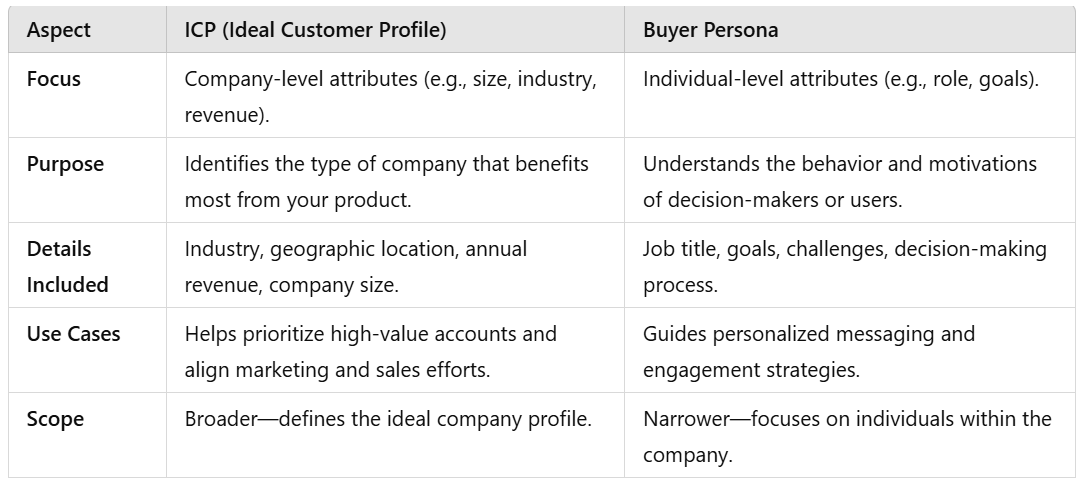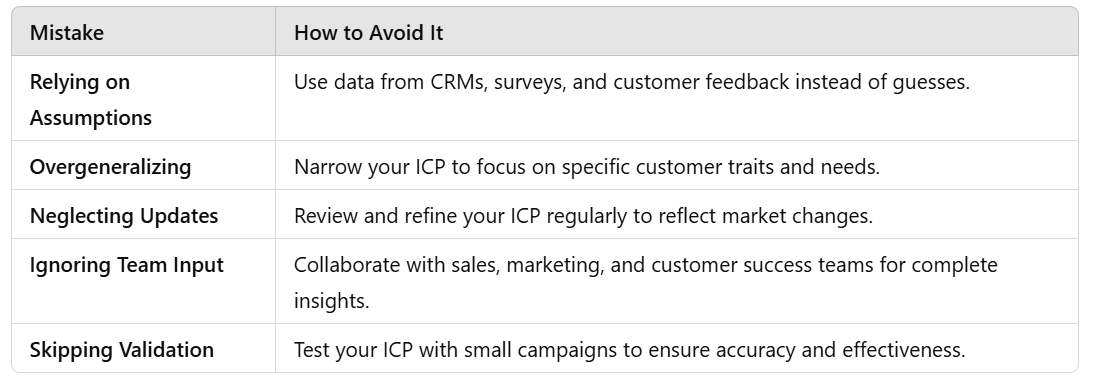What Is an ICP for Sales and Marketing? Complete Guide
What Is an ICP for Sales and Marketing? Complete Guide
Your sales and marketing efforts could see a 14% improvement in click-through rates (CTR) and a 10% conversion boost. How? Only if you have a well-defined ICP.
ICP (ideal customer profile) is the cheat sheet your sales and marketing teams need to focus on the right customers.
In this guide, we’ll walk you through everything you need to know—from what an ICP is to how it fuels better targeting, faster sales cycles, and happier customers.
What Is an ICP in Sales?
An Ideal Customer Profile (ICP) is a detailed description of the type of customer who brings the most value to your business.
Think about it. Not every lead is worth chasing. Your ICP helps your sales team focus on the right ones, saving time and effort.
How is an ICP Different from a Buyer Persona?

A buyer persona is about the individual—like their job title, goals, or challenges.
An ICP, on the other hand, focuses on the company’s key traits, like:
- Company size
- Industry
- Annual revenue
- Geographic location
For example, if your product solves problems for small tech startups with fewer than 50 employees, that’s your ICP. It tells you who to target, not just how to talk to them.
The Importance of an ICP in Sales and Marketing
Having an Ideal Customer Profile (ICP) is like having a GPS for your marketing and sales strategies. It tells you exactly where to focus your time, energy, and resources.

Here’s why it matters:
1. Better Alignment Between Teams
Without clear direction, sales teams and marketing teams often work on separate pages. An ICP changes that.
For instance, if your ICP targets companies with over $10M in annual revenue and a specific tech stack, both teams can focus on building strategies to attract and convert these high-value customers.
The result? No more wasted effort chasing the wrong type of customers.
2. Improved Lead Quality and Conversion Rates
An ICP narrows your focus to qualified leads who actually need your product. That means fewer cold leads and more promising conversations.
For example, a B2B company selling project management software uses its ICP to target businesses with complex workflows and remote teams. By focusing on this segment, they see higher conversion rates and customer satisfaction.
3. Prioritized Resource Allocation
Not all leads are created equal. Your ICP helps you prioritize where to invest your resources.
For example, a sales team might allocate their time to companies with growth potential based on employee count or revenue trends. Meanwhile, the marketing strategy might focus on crafting personalized campaigns to attract these ideal clients.
4. Faster Sales Cycles
A clear ICP helps speed up your sales process by focusing on leads ready to convert.
Here’s how:
- No More Guessing
Your sales reps know exactly who to target. For example, if your ICP identifies companies with over 200 employees and a need for workflow automation, your team spends less time qualifying and more time engaging. - Tailored Sales Pitches
Sales reps can craft messages that directly address specific pain points. If your product reduces operational bottlenecks, your pitch highlights how it saves time and improves efficiency for similar-sized organizations. - Better Use of Sales Resources
Instead of spreading resources thin across random prospects, your team can focus on fewer, more high-value leads. For instance, targeting firms in the healthcare sector with outdated tech stacks ensures your solution is a natural fit. - Streamlined Buying Process
When leads match your ICP, the buying process becomes smoother. They already see the value in your offer, so your reps don’t need to over-explain or over-sell.
For example, a company selling team collaboration software focused on mid-sized tech firms with remote employees. By aligning their sales pitches with common objections like “hard-to-track tasks,” they closed deals 30% faster than before.
5. Higher ROI on Efforts
Every ad, email, or pitch becomes more effective when you know exactly who you’re talking to. Your ICP ensures your efforts bring maximum returns.
An ICP is your best tool for making every sales effort count. When you target the right potential clients, the results speak for themselves.
Key Elements of an Effective ICP
An Ideal Customer Profile (ICP) is your playbook for finding and serving the right customers. To create one that works, go beyond the basics and dig into the details.

Let’s break it down.
1. Firmographics: Who Are They?
Start with the big picture. Firmographics are the foundational data points about a company.
These include:
- Industry: What sector do they operate in?
- Revenue: How much do they make annually? For example, if your product is premium-priced, focusing on businesses with annual revenues above $10M ensures they can afford it.
- Company Size: Number of employees or locations.
2. Technographics: What Tools Are They Using?
Understanding a company’s tech stack can give you a huge advantage.
- Software Preferences: Are they using platforms your product integrates with? For example, a CRM provider might target companies using outdated software that doesn’t allow automation.
- Gaps in Their Stack: What’s missing in their tools? Knowing their tools lets you position your product as a natural fit.
3. Behavioral Data: How Do They Act?
Look at how your ideal customers behave. This goes beyond what they use to how they work.
- Buying Patterns: Are they open to long-term commitments or prefer short-term contracts?
- Engagement Channels: Do they interact with email, social media, or webinars?
4. Pain Points
What keeps them up at night?
Every company has challenges they’re trying to solve. Your ICP should highlight these pain points and how your product addresses them.
- Operational Challenges: Are they spending too much time on manual processes? For example, a workflow automation tool can target companies drowning in spreadsheets and repetitive tasks.
- Growth Barriers: Are they struggling to scale?
5. Decision-Making Process
Knowing how decisions are made can help you tailor your approach.
- Decision-Makers: Are you targeting CEOs, managers, or team leads?
- Influencers: Who else might impact the decision?
6. Location
Geography can play a big role in shaping your ICP.
- Regional Needs: Some areas may have unique requirements.
For example, a product marketing agency could focus on companies in tech hubs with high competition for visibility. - Time Zones: Do your teams need to align on working hours?
Steps to Develop an Ideal Customer Profile (ICP)
Building an Ideal Customer Profile (ICP) is piecing together a puzzle. You gather the data, connect the dots, and end up with a clear picture of your perfect customer.

Here’s how you do it:
1. Analyze Your Current Customers
Start with what you already know. Your current customers are a goldmine of information.
- Identify Trends: Look at who brings in the most revenue or stays with you the longest.
- Customer Feedback: What are they saying about your product? Dig into surveys, reviews, or direct conversations to find patterns.
2. Segment by Revenue, Retention, and Satisfaction
Not all customers are created equal. Group them based on key factors.
- Revenue: Who spends the most? For example, a subscription service might focus on clients with higher renewal rates.
- Retention: Which customers stick around? Long-term clients often share similar traits, like industry or company size.
- Satisfaction: Look for valuable customers who love your product. These are the ones who’ll refer others.
3. Research Market Trends
You’re not working in a vacuum. Understanding the broader market can give you a competitive edge.
- Industry Trends: What’s happening in your target industry?
4. Competitive Analysis
Understanding your competitors can give you a clear edge in refining your ICP.
- Who Are They Targeting? Look at the companies your competitors focus on. Are there segments they’re overlooking? For example, If they’re targeting large enterprises, you might uncover opportunities with mid-sized businesses that need similar solutions.
- What Gaps Are They Leaving? Pay attention to their messaging. What pain points are they addressing? For example, If they emphasize cost savings, you could stand out by highlighting scalability or time efficiency instead.
5. Collaborate Across Teams
Your sales, marketing, and customer success teams see different parts of the customer journey.
Bring them together to build a more complete ICP.
- Sales Insights: What objections do they hear most often? What’s a common reason deals close—or fall through?
- Marketing Input: What types of leads engage most with campaigns?
- Customer Success Stories: Which customers are seeing the best results?
6. Validate and Refine Regularly
Your ICP isn’t a set-it-and-forget-it document. Markets change, industries evolve, and customer needs shift.
- Review Quarterly: Check if your ICP is still accurate.
- Test and Adjust: Run small campaigns targeting your ICP. Use the results to refine it further.
How to Use an ICP in Sales
An Ideal Customer Profile (ICP) doesn’t just sit on a shelf—it’s your team’s roadmap to closing deals faster and smarter.

Here’s how to put it into action:
1. Prioritize High-Value Accounts
Not all leads are worth your time. With a clear ICP, your team knows which accounts are worth pursuing.
- Focus on Fit: Let’s say your ICP highlights businesses with over $5M in annual revenue that need a robust customer support system. Your sales reps can focus their efforts on these accounts, skipping the smaller ones that don’t align.
2. Personalize Outreach and Engagement
One-size-fits-all messaging doesn’t work. Your ICP gives your team the insight they need to tailor their sales approach.
- Custom Messaging: Use the details from your ICP—like industry challenges or common objections—to craft personalized emails and calls.
If your ICP includes companies in healthcare, your outreach can highlight how your product streamlines compliance and patient management.
3. Align Sales Pitches with Pain Points
When your pitch speaks directly to a customer’s problems, it’s easier to keep their attention.
- Highlight Solutions: If your ICP shows potential customers struggle with scaling their operations, your pitch can focus on how your product supports growth without adding complexity.
4. Leverage ICP Insights for Account-Based Marketing (ABM)
An ICP is the backbone of ABM strategies. It helps you create highly targeted campaigns that resonate.
- Narrow the Focus: Instead of casting a wide net, concentrate on key accounts that match your ICP.
Tools and Platforms for Building an ICP

Here are some must-have tools for building an ICP:
1. CRMs for Centralized Data
A CRM is your go-to for collecting and organizing customer information.
- How It Helps: CRMs like HubSpot or Salesforce store data about existing customers, leads, and their interactions with your team. This gives you a clear view of the patterns and trends that shape your ICP.
2. Data Analytics Platforms
Analytics tools dig deeper into customer behavior, showing you what works and what doesn’t.
- How It Helps: Platforms like Google Analytics or Mixpanel help track website traffic, user engagement, and conversion rates.
3. AI-Driven Customer Segmentation
AI tools help you identify patterns you might miss on your own.
- How It Helps: Tools like ZoomInfo or Clearbit use AI to segment customers based on common attributes like company size, revenue, and tech stack.
4. Collaboration Tools
ICP development is a team effort. Collaboration tools ensure everyone contributes their insights.
- How It Helps: Tools like Slack or Trello let sales, marketing, and customer success teams share feedback in real-time.
Common Mistakes to Avoid When Creating an ICP
Building an Ideal Customer Profile (ICP) can transform your sales and marketing strategies, but it’s easy to get things wrong.
These mistakes can derail your efforts, leading to wasted resources and missed opportunities.

Here’s what to avoid:
1. Relying on Assumptions
Assumptions might feel like shortcuts, but they lead to inaccurate profiles.
- Why It’s a Problem: Basing your ICP on gut feelings rather than real data can mean chasing the wrong leads.
- How to Fix It: Use customer data from CRMs, surveys, and interviews. For example, analyze feedback to identify recurring themes instead of guessing your customers’ pain points.
2. Overgeneralizing Your Target Market
Trying to appeal to everyone means appealing to no one.
- Why It’s a Problem: A broad ICP makes it hard to create focused and clear messaging or identify valuable leads.
- How to Fix It: Narrow down your target audience. For example, instead of targeting “retailers,” focus on “mid-sized online retailers struggling with inventory management.”
3. Neglecting to Update the ICP
An outdated ICP doesn’t reflect shifts in the market or customer behavior.
- Why It’s a Problem: Market trends and customer needs change. Ignoring these shifts makes your ICP less effective over time.
- How to Fix It: Review and refine your ICP regularly. Adjust your profile accordingly if new industries or customer types emerge as potential buyers.
4. Ignoring Input from Other Teams
Your sales team, marketing team, and customer success team all interact with customers in different ways. Leaving them out creates blind spots in your ICP.
- Why It’s a Problem: A one-sided ICP misses valuable insights.
- How to Fix It: Collaborate across teams. For example, your sales reps might flag recurring objections, while your marketing team identifies what drives engagement.
5. Skipping Validation
If you don’t test your ICP, you’ll never know if it’s working.
- Why It’s a Problem: An untested ICP could lead to targeting unqualified leads.
- How to Fix It: Run small campaigns to see if your ICP aligns with actual results. If the leads generated don’t convert, revisit your profile and make adjustments.
Conclusion
An Ideal Customer Profile (ICP) helps you target the right customers, align your teams, and boost results. It’s your starting point for smarter sales and marketing.
If you’re ready to refine your ICP or need help creating one, Aventi Group specializes in tailored go-to-market strategies for B2B tech.
Ready to refine your ICP and create a strategy that works? Contact us and let’s craft a plan that aligns with your business goals.
FAQs
1. How often should I update my ICP?
It depends on how quickly your market changes. For most, reviewing and refining your ICP every 6-12 months works. If your industry evolves faster, check quarterly. Your ICP should grow with your business and customer needs.
2. What’s the difference between an ICP and a buyer persona?
An ICP focuses on the company’s traits—like size, revenue, and challenges.
A buyer persona is about the individuals in those companies—like their roles, goals, and pain points. Think of it as the “who” versus the “what.”
3. Can I have more than one ICP?
Yes, if your product serves different markets or segments, you can have multiple ICPs. Just make sure each one is specific and backed by data.
4. What if my ICP feels too narrow?
That’s okay. A narrow ICP is better than one that’s too broad. It helps you focus on high-quality leads instead of chasing everyone. You can always expand later as you grow.
5. What’s the easiest way to start creating an ICP?
Look at your best customers. Who spends the most, stays the longest, or gives the best feedback? Start there, and refine as you gather more data.
6. Do I really need an ICP if I’m just starting out?
Yes! Even a basic ICP can guide your marketing and sales efforts. It’s better to start small and refine than to go in blind.




